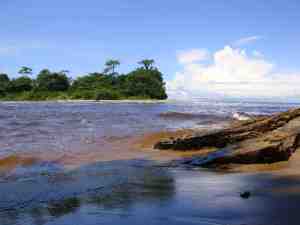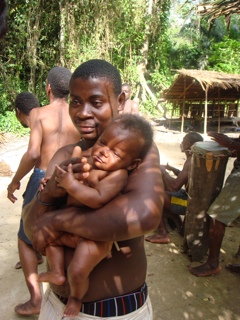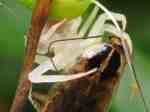 NODYCOS-2011 is the International School on Non-linear Dynamics in Complex Systems, being held at the University of Yaoundé. Having agreed to come here earlier this year to lecture on the applications of Nonlinear Dynamics to Biology, I found myself on a flight from Brussels to Nsimalen last Friday.
NODYCOS-2011 is the International School on Non-linear Dynamics in Complex Systems, being held at the University of Yaoundé. Having agreed to come here earlier this year to lecture on the applications of Nonlinear Dynamics to Biology, I found myself on a flight from Brussels to Nsimalen last Friday.
All the things that could go wrong did, of course. I had not had my yellow fever vaccination (so I got it at the airport, much use that). The transportation that had been sent to get me gave up after a long wait- my “visa on arrival” entailed much delay and negotiation and stretched my non-existent French to the fullest, so when I emerged with the visa, there were only predatory taxi-wallahs who homed in on me to take me to downtown Yaoundé for what seemed like an astronomical amount. I capitulated… Je suis fatigué can be used only so often.

The drive had its moments. One thing about living in India, most other places seem like somewhere familiar. On the outskirts, Yaoundé seemed very much like one of the smaller Indian towns, Indore, Tiruchi, or Bhubaneswar some years ago maybe? On the other hand, Yaoundé is hilly, so images of Aizawl flitted by occasionally. And it is also quite French colonial, so Pondicherry came to mind too… Posters proclaiming the gratitude of the President, Paul Biya, for being elected- making this his 29th year at the helm of affairs- festoon the place, so by the time I reached my hotel, I was fully indoctrinated by Paul the taxi driver and tres tres fatigué to boot.

Navigating through this part of the world for the first two days was mostly social since it was le weekend– with a trip to the seaside town of Kribi (with a side trip to a so-called village of the people of the forest), seeing a lowland gorilla close up in a reserve, a canoe (pirogue) ride through a partly submerged forest… And a run in with the militia for not carrying my passport at all times (and that seemed very much like something out of a despatch from Ryszard Kapuscinski).
__________
So much for the pretty beach picture, the work part now. The poster says: NODYCOS 2011, the first school of its kind to be organized in Cameroon (by the ICTP Trieste, Italy) aims at bringing together students and leading experts with diverse backgrounds in applied physics, theoretical physics and computational physics, to share insights on the state-of-the-art of efficient forefront analytical and computational approaches to models governing nonlinear physical processes.
The ICTP in Trieste has played a major role in nurturing physics and mathematics in the developing world, thanks in great measure due to the vision of its founder, Abdus Salam. Its outreach activities are impressive, and this School is another example of what the ICTP has done well in the past (nearly) 50 years. NODYCOS expands to NOnlinear DYnamics in COmplex Systems, a common way in which acronyms seem to be constructed here, phonetics being as important as brevity. Other delightful examples are SOACAM (the SOciete Alimentaire de CAMeroon) and FINUTRASU (the Fako INter-Urban TRAnsporters Union).
 Arriving at the University this morning, it was good to see a large group of enthusiastic students. Not all were there to study chaos, it turned out that a few had come- Eid notwithstanding- for their distance education classes. The real surprise for me was that these were students of Amity University in Noida- all taking the e-learning modules in finance, tourism management and other subjects. From what I was able to gather, there were 60 students in Cameroon, and about 500 in all of Africa, and the government had sponsored them for this 3 year course. Other private Indian Universities- Manipal among them- have also heavily invested in the distance learning mode, and much of their outreach is in Africa where the need is large, and an Indian solution is both inexpensive and highly regarded. There is a lesson here somewhere for us…
Arriving at the University this morning, it was good to see a large group of enthusiastic students. Not all were there to study chaos, it turned out that a few had come- Eid notwithstanding- for their distance education classes. The real surprise for me was that these were students of Amity University in Noida- all taking the e-learning modules in finance, tourism management and other subjects. From what I was able to gather, there were 60 students in Cameroon, and about 500 in all of Africa, and the government had sponsored them for this 3 year course. Other private Indian Universities- Manipal among them- have also heavily invested in the distance learning mode, and much of their outreach is in Africa where the need is large, and an Indian solution is both inexpensive and highly regarded. There is a lesson here somewhere for us…
There was more to learn- in particular about opportunities for African researchers to come to India. Amazingly enough, FICCI and the Department of Science & Technology have initiated the C V Raman International Fellowships to promote scientific cooperation with Africa. There are opportunities for African researchers to collaborate with groups in Universities and other Indian institutions in various areas of Science & Technology.
Each of the participating African nations have been given 8 fellowships, and these are at the post doctoral, junior and senior levels totaling about 24 man-months. That I had not heard about it until a Nigerian student at the School told me is not clear evidence that the fellowship has not been widely advertised, but still… Given the widespread enthusiasm for the Indian educational system that I see here, the real need and the vast potential, I think this is an excellent opportunity for us to do something meaningful!
__________
 I did go around the central part of downtown Yaoundé, chancing upon the few Indian stores that mostly sell mixed goods- a catchall phrase for just about anything from LG TVs to baby clothes. The community is small, but will be getting together to celebrate Gurupurab on Thursday… The Consul General of India in Cameroon, Mr J Ravikumar, has been doing a great deal to further relations between the countries- in particular the effort in e-learning and telemedicine is largely thanks to his initiative. It should be added, of course, that the Indian Government has put in a large amount of money into this- apart from the CV Raman Fellowships, there is the Indo-Africa Virtual University (IAVU) that was announced earlier this year.
I did go around the central part of downtown Yaoundé, chancing upon the few Indian stores that mostly sell mixed goods- a catchall phrase for just about anything from LG TVs to baby clothes. The community is small, but will be getting together to celebrate Gurupurab on Thursday… The Consul General of India in Cameroon, Mr J Ravikumar, has been doing a great deal to further relations between the countries- in particular the effort in e-learning and telemedicine is largely thanks to his initiative. It should be added, of course, that the Indian Government has put in a large amount of money into this- apart from the CV Raman Fellowships, there is the Indo-Africa Virtual University (IAVU) that was announced earlier this year.
Meanwhile, a colleague shared a link to the New York Review of Books’ article by Anthony Grafton, a thought provoking piece titled Our Universities: Why Are They Failing? I found some time to go over it today, and in case any of you have wondered if there is indeed cause for concern, this article gives a special insight into the US university system and its challenges at this time. The essay is a good read and thought provoking to boot. One aspect that I thought that we should keep in mind as we think of growth and change is Grafton’s comment that (in the books he was reviewing) “two points come through with striking clarity. First, traditional subjects and methods seem to retain their educational value. Nowadays the liberal arts attract a far smaller proportion of students than they did two generations ago. Still, those majoring in liberal arts fields—humanities and social sciences, natural sciences and mathematics—outperformed those studying business, communications, and other new, practical majors […]. And at a time when libraries and classrooms across the country are being reconfigured to promote trendy forms of collaborative learning, students who spent the most time studying on their own outperformed those who worked mostly with others.”
__________
The past few days have been busy with lectures mainly, with something like 80 students, the bulk of who are from Cameroon, but there is representation from other states in the region. 11.11.11 is the last day of lectures- in fact the last day of NODYCOS- and at lunch today I discovered a startling fact. No Ph D student at the University of Yaoundé receives any sort of fellowship. There is simply no equivalent of the UGC’s scholarships for all registered Ph D students, let alone anything like the JRF or SRF’s that enable most students in our country to pursue their doctorates. And, of course, this is a serious impediment to higher learning in an already poor country. In spite of that, there are 100 students in the Ph D program in the Physics department alone, though with this level of governmental support, one can only imagine what other hurdles they have to cross. The thought did, I must say, cross my mind: What would our enrollment be if no scholarships were offered? Both in terms of quality and quantity…

Coming away at the end of a week of varied experience, one can only be struck by the similarities of our two situations. A colonial past, a diverse linguistic composition, considerable and visible poverty and inequality. Differences too, and probably these determine the two very different trajectories we have taken. But still, there is a great opportunity here, and I believe it is to our advantage to participate- in some way in this globalized and connected world- by providing opportunities to the Africa that is anxious for and enthusiastic about higher education. Postdoctoral training, in particular, is something that we should be able to offer and with very little effort on our part, this would be very attractive to most of the students here.




























